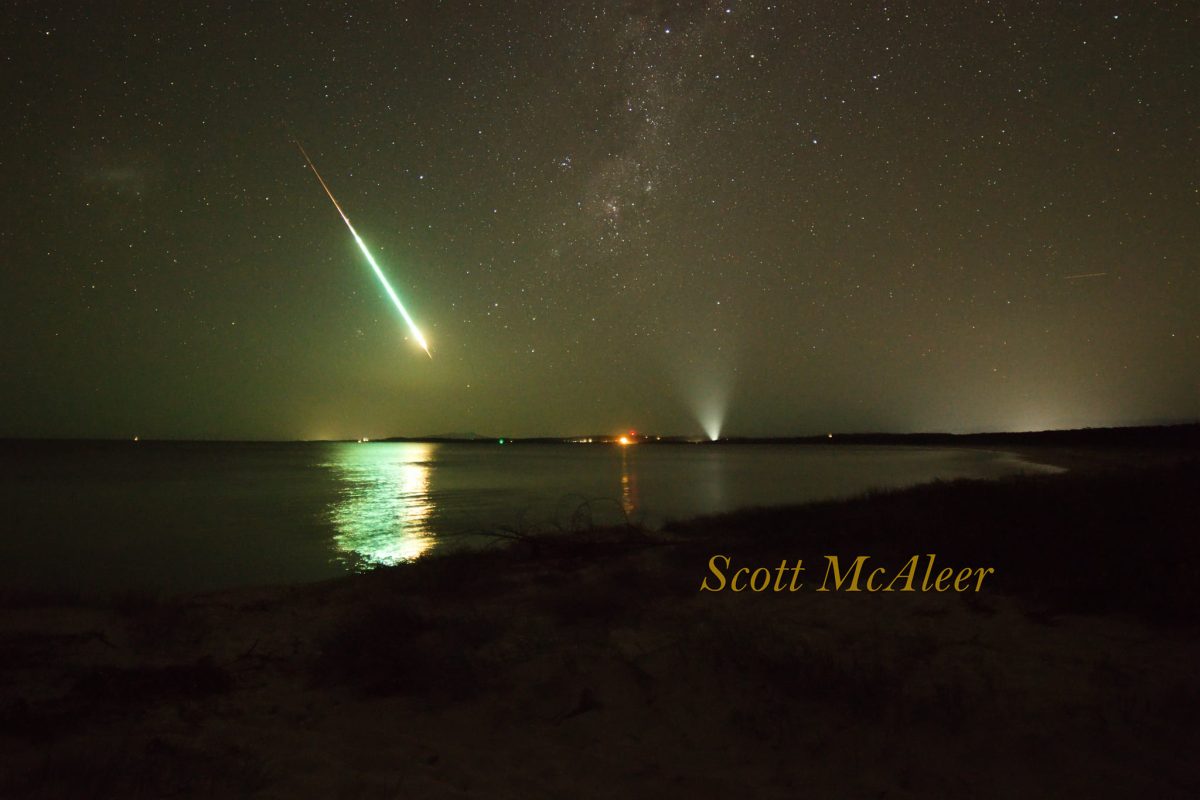
The meteor appeared to fall over the South Coast. Photo: Doug Ingram.
You could hardly make this up.
Sydney-sider Doug Ingram has visited Tuross Head for family holidays since the 1970s and has ventured out after dark to take photos of stars since he borrowed his mum’s old black-and-white film camera as a kid.
“Astrophotography has been my hobby, or as my wife would say, my obsession, for the last 10 years,” he says.
For the Father’s Day just past, he asked his wife if he could “go to Tuross on my own, with my camera”.
That morning, he met Scott McAleer, another avid photographer of the night sky who was visiting Tuross for the first time with his wife, and the two talked about how they planned to head out that night to try their luck capturing the International Space Station passing over.
As soon as it was dark, Doug set up his camera near a dead tree in Bodalla and clicked off a test shot.
It was the exact moment a flaming ball of fire speared across the sky.
“A ball of orange light suddenly appeared in the sky, and then it burned green and got brighter before it faded towards the end,” he says.
“There was a faint but audible crackling noise as well as it disintegrated.”
His immediate reaction was to yell out a “Yes!” … although he was conscious not to wake the neighbours further up the laneway.
“I was very, very excited, and thought, ‘Gee, I could go back to the house now and start editing that and post it’, but I wanted to stay.”
Meanwhile, at the very same moment, about 28 km north of Doug in Broulee, the photographer he’d happened to meet that very morning happened to press the shutter button at the same time.
“I was just taking my first pic of a panorama and BOOM,” Scott posted to the Australian Meteor Reports group on Facebook that night.

Scott’s photo of the meteor, captured from Broulee. Photo: Scott McAleer.
Both Doug and Scott have since exchanged notes, each “blown away that this person I’d met less than 24 hours earlier had got the same thing”.
“It’s nuts,” Doug says.
Dr Brad Tucker, an astrophysicist from the Australian National University (ANU), confirmed the meteor – “a good-size one, probably half a meter to a metre in size” – was visible across the ACT region on Sunday night.
But despite the fact it might have appeared to have crash-landed somewhere along the coast, chances are it never made it to ground.
“The blue-green colour is the iron and nickel burning and heating up,” Dr Tucker explained.
“It most likely went further over the ocean – they are travelling so fast they sometimes appear to land close, but really, it is an illusion. As they go toward the horizon, they look like they are curving or falling, but in reality, keep going for much further.
“If any fragments fell to the ground, while probably not likely, they would be over the ocean.”
The Earth’s atmosphere is peppered with thousands of meteors every year, almost all of them originating from shattered asteroids (99.8 per cent), although some also come from Mars or the Moon.
Less than 5 per cent of each one’s original mass ever reaches the ground, but if it does survive its trip through the atmosphere, it’s called a meteorite.
The chances of one causing any damage are even smaller.
“Most of the Earth is uninhabited, so the likelihood of passing over populated areas is low,” Dr Tucker says.
“The vast majority do burn up on entry, as they are small – sometimes just a small rock or even a pebble – and those that may survive are likely to land in the ocean.”
Both Doug and Scott have been approached by a group looking to find out if the meteor they captured on Sunday night did, in fact, land.
“It’s hard to say where it might have landed because of the reflection over the ocean … but I saw people in the Australian Meteor Reports group from Eden, Bemboka and up to Coffs Harbour who saw it, and then there was lots of dash-cam footage from the Monaro region,” Doug says.
Original Article published by James Coleman on Riotact.







